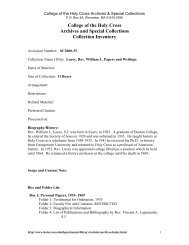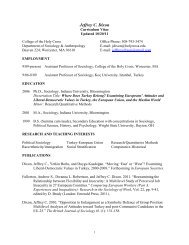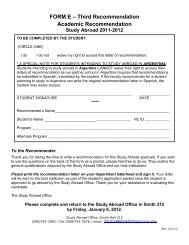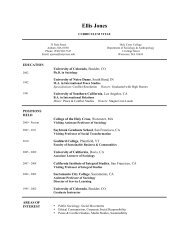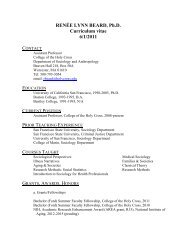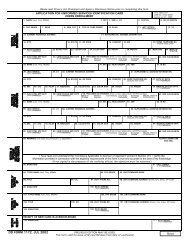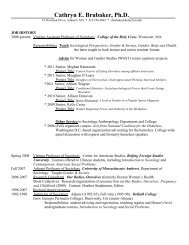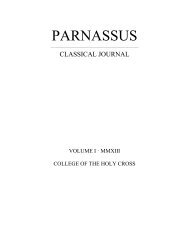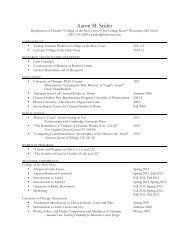Control of frequency in cricket song - The Journal of Experimental ...
Control of frequency in cricket song - The Journal of Experimental ...
Control of frequency in cricket song - The Journal of Experimental ...
You also want an ePaper? Increase the reach of your titles
YUMPU automatically turns print PDFs into web optimized ePapers that Google loves.
1966; Koch et al., 1988) then, as the tegm<strong>in</strong>a close, f0 <strong>of</strong> the<br />
proposed subalar–tegm<strong>in</strong>al resonator would <strong>in</strong>crease s<strong>in</strong>ce<br />
the subalar volume decreases (equations 4 and 5). Our<br />
exam<strong>in</strong>ation <strong>of</strong> thousands <strong>of</strong> sound pulses from 14 <strong>in</strong>dividuals<br />
showed that, <strong>in</strong> most cases, the amplitude reached a maximum<br />
early <strong>in</strong> the call and then decayed slowly for an extended<br />
period followed by a rapid fade-out when the animal reversed<br />
its w<strong>in</strong>gs. However, it was not uncommon to see changes <strong>in</strong><br />
this pattern with<strong>in</strong> an <strong>in</strong>dividual, even over a short period.<br />
Most significantly, the calls <strong>of</strong> O. celer<strong>in</strong>ictus and O.<br />
quadripunctatus showed the same patterns even though these<br />
species lack a subalar space.<br />
Carrier <strong>frequency</strong> and SPL <strong>in</strong> air and heliox<br />
Table 2 gives the mean fC and fWS for all three species <strong>in</strong> air<br />
and heliox-air at 25 °C. <strong>The</strong> values for air agree well with those<br />
previously published for the same species (Walker, 1963,<br />
1973; Prestwich and Walker, 1981). Plac<strong>in</strong>g A. arboreus <strong>in</strong><br />
heliox-air resulted <strong>in</strong> a statistically significant average 1.14fold<br />
<strong>in</strong>crease <strong>in</strong> fC with no statistically significant differences<br />
<strong>in</strong> fWS. When we determ<strong>in</strong>ed mean SPL values <strong>in</strong> air and <strong>in</strong><br />
heliox-air for each <strong>of</strong> five <strong>in</strong>dividuals (based on 2–4 separate<br />
measurements per <strong>in</strong>dividual per atmosphere), a paired t-test<br />
showed no statistically significant differences (P=0.24). <strong>The</strong><br />
mean SPLs <strong>in</strong> both atmospheres for each <strong>in</strong>dividual were<br />
always with<strong>in</strong> ±2 dB <strong>of</strong> each other; <strong>in</strong> two cases, the mean SPL<br />
<strong>in</strong> heliox-air was slightly higher than the mean SPL <strong>in</strong> air,<br />
while <strong>in</strong> the rema<strong>in</strong><strong>in</strong>g three cases the SPL <strong>in</strong> heliox-air was<br />
slightly lower than <strong>in</strong> air. Sound pressure level measurements<br />
were difficult for technical reasons (see Materials and<br />
methods). Some uncerta<strong>in</strong>ty is therefore <strong>in</strong>herent <strong>in</strong> these<br />
measurements, but it is not so great as to underm<strong>in</strong>e the<br />
conclusions drawn from these data.<br />
Fig. 4 gives the <strong>frequency</strong> spectra for representative s<strong>in</strong>gle<br />
sound pulses <strong>in</strong> air and heliox-air for an <strong>in</strong>dividual A. arboreus.<br />
<strong>The</strong> pr<strong>in</strong>cipal difference is an upward shift <strong>in</strong> <strong>frequency</strong> <strong>in</strong><br />
heliox-air. <strong>The</strong> spectra from seven <strong>in</strong>dividuals showed m<strong>in</strong>or<br />
<strong>frequency</strong> peaks <strong>in</strong> addition to the fC, but these were not<br />
consistent from <strong>in</strong>dividual to <strong>in</strong>dividual. Furthermore, spectra<br />
for sound pulses taken from the same <strong>in</strong>dividual at different<br />
times showed variation <strong>in</strong> the positions <strong>of</strong> these <strong>frequency</strong><br />
peaks. We found no evidence <strong>of</strong> a consistent <strong>frequency</strong> peak<br />
<strong>Control</strong> <strong>of</strong> <strong>frequency</strong> <strong>in</strong> <strong>cricket</strong> <strong>song</strong><br />
Table 2. Carrier frequencies and w<strong>in</strong>g stroke rates <strong>in</strong> air and heliox-air for three <strong>cricket</strong> species<br />
fC (kHz) fWS (Hz)<br />
Ratio Ratio<br />
Species N Air Heliox-air P (heliox/air) Air Heliox-air P (heliox/air)<br />
Anurogryllus arboreus 5 5.73±0.25 6.51±0.44



